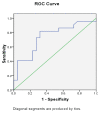Knee Extensor Muscle Strength to Measure the Ability of Five Times Sit to Stand Independently in Patients with Incomplete Spinal Cord Injury
- PMID: 36474537
- PMCID: PMC9681008
- DOI: 10.21315/mjms2022.29.5.8
Knee Extensor Muscle Strength to Measure the Ability of Five Times Sit to Stand Independently in Patients with Incomplete Spinal Cord Injury
Abstract
Background: Patients with incomplete spinal cord injury (iSCI) and lower extremity muscle weakness often fall while standing up from a chair. The sit-to-stand (STS) task primarily uses the strength of the knee extensor muscles. The five times sit-to-stand test (FTSST) is often applied to determine lower limb function and the results are related to lower extremity muscle strength. This study explored the cut-off point for knee extensor muscle strength in patients with iSCI to independently determine their FTSST results and the correlation between knee extensor muscle strength and FTSST results.
Methods: Forty-four participants were assessed for knee extensor muscle strength using a hand-held dynamometer (HHD) and the FTSST.
Results: The data indicated that knee extensor muscle strength ≥ 53.06 Newton was the best independent predictor of the FTSST results (sensitivity 72.7%, specificity 72.7%). Moreover, knee extensor muscle strength was significant and correlated with the FTSST results (r = -0.45, P = 0.035).
Conclusion: The findings offer a cut-off point for the knee extensor muscle strength measured while standing up from a chair that may help medical professionals set rehabilitation goals for patients with iSCI.
Keywords: falls; muscle strength dynamometer; reference value; rehabilitation; spinal cord injury.
© Penerbit Universiti Sains Malaysia, 2022.
Conflict of interest statement
Conflict of Interest None.
Figures
References
LinkOut - more resources
Full Text Sources

